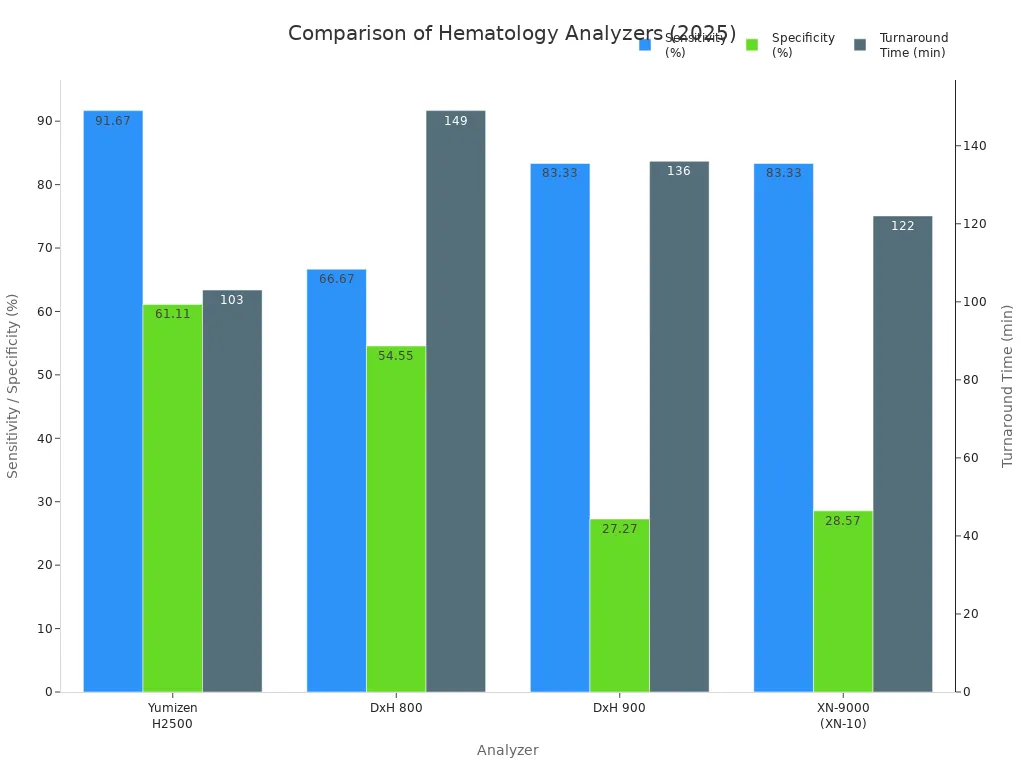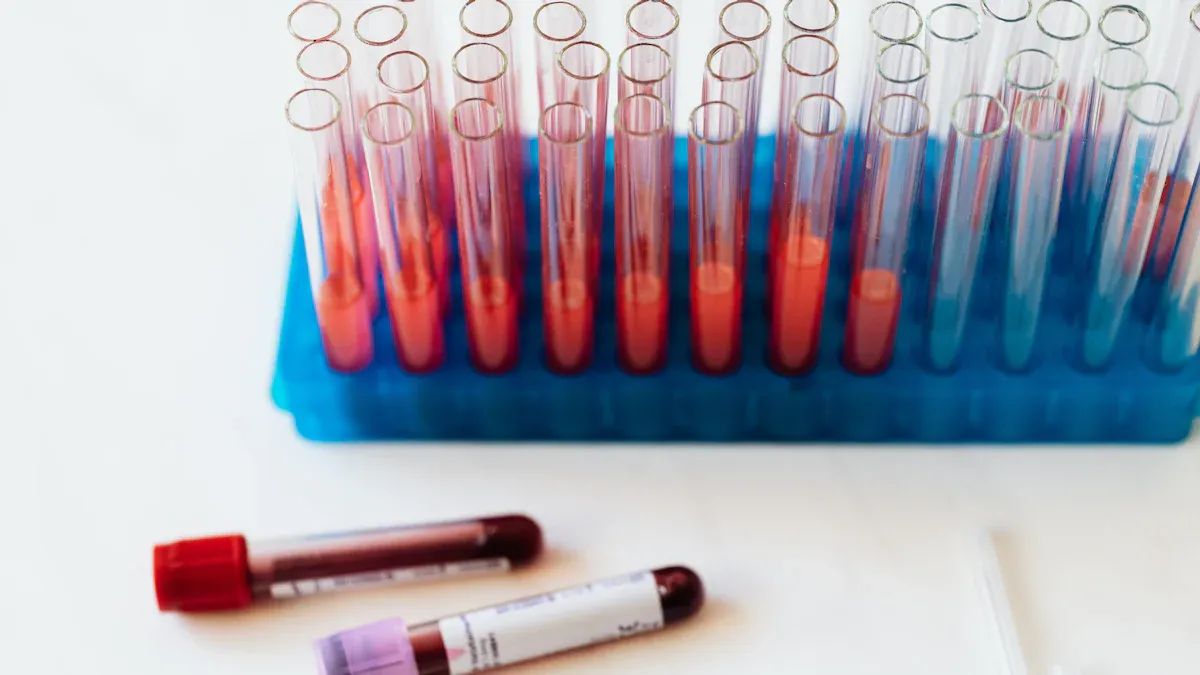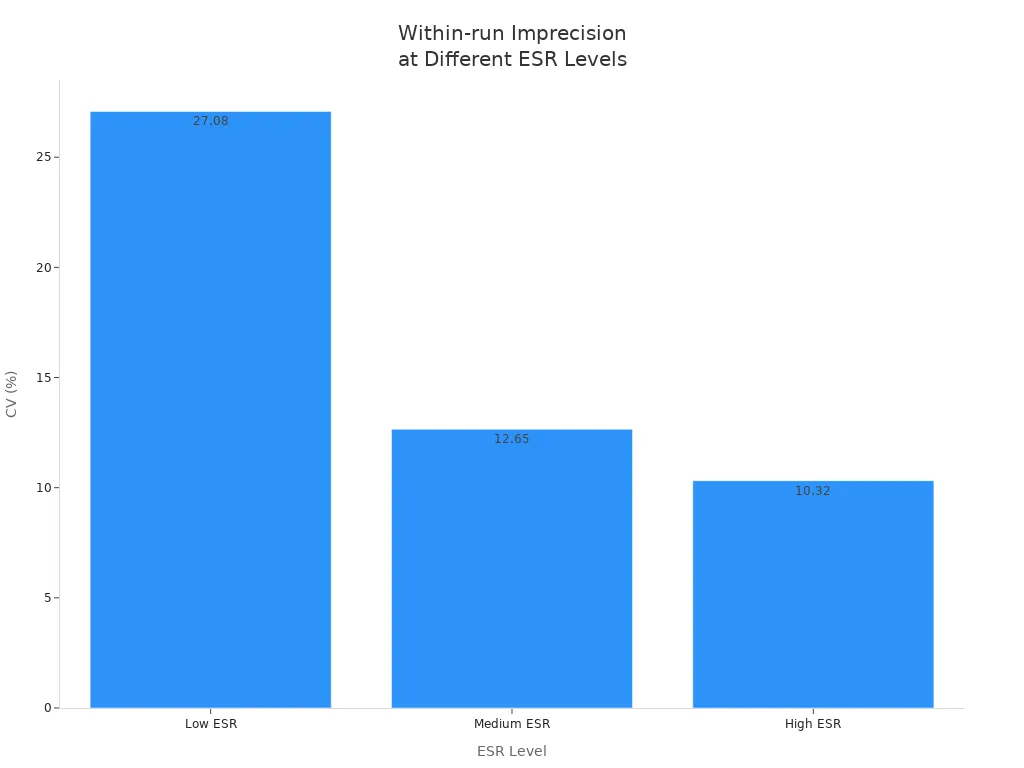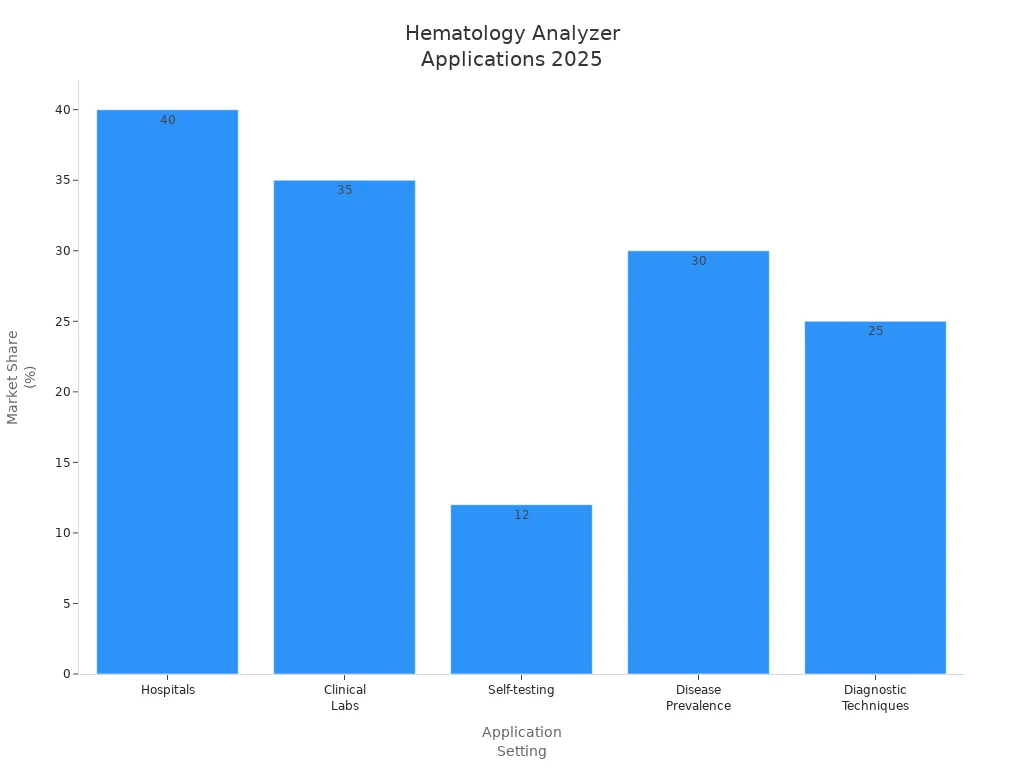Views: 0 Author: Site Editor Publish Time: 2025-08-08 Origin: Site










In 2025, hematology analyzers do many important lab tests for patients. The most common blood tests are complete blood count (CBC), white blood cell count analysis, differential counts, reticulocyte analysis, and coagulation testing. The table below shows how these tests are used:
Blood Test Type | Description / Usage Context | Usage Rate (2025) |
|---|---|---|
Complete Blood Count (CBC) | Measures red and white cells, hemoglobin, hematocrit | Widely performed, rapid devices |
White Blood Cell Count | Detects infections, immune issues, blood disorders | Central to analyzers |
Differential Counts | Analyzes white cell subtypes in detail | 57.3% market share for analyzers |
Reticulocyte Analysis | Detects anemia, monitors blood disorders | Supported by advanced analyzers |
Coagulation Testing | Diagnoses clotting disorders | Growing use in point-of-care labs |
Hematology analyzers now use AI, better flow cytometry, and more automation. These new tools help labs do more tests and get better results. Labs can give results faster and with more accuracy. Patients get help sooner and doctors can watch blood problems more closely.
Hematology analyzers do important blood tests fast and well. They check things like complete blood count, white cell analysis, reticulocyte count, and coagulation tests. New tools like AI, flow cytometry, and automation help labs get better results. These tools also make testing faster. These analyzers help doctors find diseases early. They can also help watch diseases like anemia, infections, blood cancers, and clotting problems. Advanced tests like reticulocyte count and nucleated red blood cell detection give more details. They help doctors learn about bone marrow health and blood disorders. Portable and automated analyzers let people test blood in many places. You can use them in hospitals, clinics, and even at home. This helps doctors take better care of patients and watch their treatment.
A hematology analyzer is a machine used in labs. It checks blood samples automatically. It gives details about red cells, white cells, and platelets. These machines do tests like complete blood counts and cell counts. They help doctors find and watch blood problems like anemia and leukemia. They also help find infections. Automated hematology analyzers give fast results. This helps labs work better and more accurately. They can test many samples quickly. Hospitals, clinics, and labs need these machines.
Hematology analyzers work faster and better than manual ways. They help find diseases early and treat patients quickly. Their automatic systems count blood cells and tell them apart fast. They also look at cell shapes. These machines make labs work better and improve test quality. They help doctors do research and check if treatments work.
Main jobs of hematology analyzers:
Find and watch blood problems
Do complete blood counts and cell counts
Use new technology for better results
Test lots of samples and help labs work faster
Hematology analyzers use different tools to check blood. Electrical impedance looks at cell size and shape. It does this by moving cells through a small space and checking resistance. Flow cytometry uses special markers and lasers. It checks many cell features at once. This makes tests more accurate. Spectrophotometry checks hemoglobin by seeing how much light is absorbed. These methods help analyzers give good results and test many samples.
Technology | Main Use | Accuracy Level | Efficiency | Cost |
|---|---|---|---|---|
Impedance | Routine CBC, 3-part differential | High | High | Lower |
Flow Cytometry | 5-part differential, rare cells | Very High | High | Higher |
Spectrophotometry | Hemoglobin measurement | High | High | Moderate |

Hematology analyzers have changed a lot since 2020. Companies now make machines that use many tools together. Some use laminar flow impedance and fluorescent cell analysis. New models like the DxH 690T can find sepsis risk early. Better reagents, hydrofluidics, and data tools make tests more accurate. More automation and better workflows help labs test lots of samples and keep results good.
New features in hematology analyzers:
Built-in flow cytometry for better results
Biomarkers to find diseases early
More automation and better workflows
Improved reagents and data tools

A complete blood count (CBC) is the most used test by hematology analyzers. It checks important parts in blood like red blood cells, white blood cells, platelets, hemoglobin, and hematocrit. CBC helps doctors find anemia, infections, swelling, and blood cancers. It also helps doctors see if treatments work and how diseases change. Hematology analyzers give quick and correct results, so CBC is very important for blood checks.
CBC gives a quick look at a patient's health. It helps doctors find problems early and watch changes over time.
CBC Parameters Table
Parameter | What It Measures | Clinical Use |
|---|---|---|
Red Blood Cells | Oxygen-carrying cells | Anemia, blood loss |
White Blood Cells | Immune system cells | Infection, leukemia |
Platelets | Clotting cells | Bleeding disorders |
Hemoglobin | Oxygen transport protein | Anemia, polycythemia |
Hematocrit | Percentage of RBCs in blood | Dehydration, anemia |
White blood cell differential shows the types and amounts of white blood cells. Hematology analyzers use new tools like flow cytometry and digital imaging to tell each cell type apart. They count neutrophils, lymphocytes, monocytes, eosinophils, and basophils. This test helps doctors find infections, swelling, and blood cancers.
Studies say automated analyzers are very good at counting neutrophils and lymphocytes. Their results match manual checks with a score over 0.9. But, doctors still check by hand if results look strange or very different.
WBC Differential Chart

Automated hematology analyzers make blood tests faster and more trustworthy. They help doctors find sickness early and watch how treatment works.
Platelet count is another main test in hematology. Platelets help blood clot and stop bleeding. Hematology analyzers count platelets fast and correctly. Platelet numbers can change by where you live, your sex, and your genes. Females usually have more platelets than males because of hormones and periods.
Doctors use platelet counts to find bleeding problems, check bone marrow, and look for clotting issues. Local reference numbers are needed for the best results. Using numbers from other places can cause mistakes.
Key Points:
Platelet counts change by group and sex.
Good reference numbers stop mistakes.
Hematology analyzers give fast platelet counts.
Red blood cell indices help find blood problems. Hematology analyzers measure these:
Mean Corpuscular Volume (MCV): Shows average red blood cell size.
Mean Cell Hemoglobin (MCH): Tells how much hemoglobin is in each cell.
Mean Cell Hemoglobin Concentration (MCHC): Shows how much hemoglobin is packed in.
Red Blood Cell Distribution Width (RDW): Tells if cell sizes are different.
Reticulocyte Hemoglobin Content (CHr): Checks iron in new red cells.
Doctors use these numbers to find anemia, thalassemia, and iron problems. Low MCV and MCH mean thalassemia. High RDW means mixed or changing anemia. Low CHr shows iron problems, especially in kidney patients.
Red Cell Indices Table
Index | What It Shows | Clinical Use |
|---|---|---|
MCV | RBC size | Thalassemia, anemia |
MCH | Hemoglobin per RBC | Iron deficiency, anemia |
MCHC | Hemoglobin concentration | Spherocytosis, anemia |
RDW | RBC size variation | Mixed anemia, evolving anemia |
CHr | Iron in reticulocytes | Iron deficiency |
Red blood cell indices help doctors pick the right treatment. They also help with full blood counts and blood studies.
Hemoglobin and hematocrit are two main blood tests. Hemoglobin shows how much oxygen blood can carry. Hematocrit tells what percent of blood is red blood cells. Hematology analyzers measure both quickly and well.
Doctors use these tests to find anemia, dehydration, and polycythemia. Low hemoglobin means anemia. High hematocrit may mean dehydration or other blood problems. These tests are needed to check health and guide care.
Summary List:
Hemoglobin: Carries oxygen, finds anemia.
Hematocrit: Shows RBC percent, checks hydration.
Both tests help with diagnosis and watching health.
Hematology analyzers in 2025 make blood tests faster, better, and more trustworthy. They help doctors find and watch many diseases. These main tests are the base of modern hematology and full blood checks.
Reticulocyte count tells how well bone marrow makes new red blood cells. Hematology analyzers use flow cytometry and special dyes to check reticulocytes fast. This test helps doctors know if the bone marrow works or not. High reticulocyte counts mean the marrow is working hard, like after losing blood or in hemolytic anemia. Low counts show the marrow is not working right, like in aplastic anemia. The absolute reticulocyte count gives more helpful details than just the percent. It helps doctors check anemia, see if treatment works, and watch the marrow after chemo or transplant.
Reticulocytes are young red blood cells with leftover RNA.
Automated hematology analyzers count reticulocytes during normal blood tests.
This test helps find anemia and see if bone marrow is getting better.
Nucleated red blood cells are not in healthy adults or kids. They are found in newborns and babies born early. If older people have NRBCs, it means something is wrong. High NRBCs can mean bone marrow stress, blood loss, leukemia, or bad infections. Hematology analyzers can find NRBCs even at low levels that people might miss. These machines use special ways like hydrodynamic focusing and fluorescence to spot young cells. NRBCs can change white cell counts, so analyzers use math to fix this. Finding NRBCs helps doctors know about marrow problems and what tests to do next.
NRBCs show bone marrow is hurt or working extra hard.
Automated hematology analyzers find NRBCs better and help doctors make choices.
Erythrocyte sedimentation rate checks how fast red blood cells fall in a tube. It helps doctors find swelling and watch some diseases. Hematology analyzers use light to see how cells settle. They also use hematocrit and mean corpuscular volume from the CBC. Automated ESR tests are almost the same as manual ones but are much faster. They need less blood and lower the chance of infection.
Aspect | Description |
|---|---|
Measurement Principle | Optical detection of RBC clumping |
Sample Volume | 80 microliters |
Assay Time | 3 minutes for each sample |
Correlation | Strong match with manual test |
Advantages | Faster, safer, less work |

Coagulation tests help doctors find bleeding or clotting problems. Hematology analyzers in 2025 do tests like prothrombin time (PT), activated partial thromboplastin time (aPTT), fibrinogen, D-dimer, and platelet function. PT checks the extrinsic pathway and helps watch warfarin use. aPTT checks the intrinsic pathway and is used for heparin therapy. Some special tests, like the serotonin release assay, find platelet-activating antibodies in heparin-induced thrombocytopenia. Optical technology in analyzers gives good results and can do many kinds of tests. These tests help doctors find clotting problems and choose the right treatment.
Test Type | What It Checks | Clinical Use |
|---|---|---|
PT | Extrinsic pathway | Warfarin use, bleeding risk |
aPTT | Intrinsic pathway | Heparin use, clotting problems |
D-dimer | Fibrin breakdown | Finds clots, checks therapy |
Platelet Function | Platelet activity | Finds platelet problems |
SRA | Platelet antibodies | Finds HIT |
Modern hematology analyzers like Abbott's Alinity h-series and Sysmex XN-9100 do advanced tests, work automatically, and are very accurate. They help busy labs and make patient care better.
Hematology analyzers are very important in today's medicine. They help doctors find and watch many diseases. Hospitals, clinics, and even some homes use these machines for good test results. The table below shows where hematology tests are used and how they help patients.
Application Setting | Market Share / Usage Statistics | Clinical Relevance / Disease Data |
|---|---|---|
Hospitals | Over 40% of application share; 60% of emergency and inpatient decisions involve hematology screening | Frequent use of CBC, coagulation, bone marrow tests |
Clinical Labs | Around 35% market share; 65% of non-hospital blood samples processed daily | Rising outsourcing and adoption of next-gen analyzers |
Self-testing | Accounts for ~12% of market; 30% of individuals prefer at-home hemoglobin testing | Growth driven by portable devices and improved compliance |
Disease Prevalence | Anemia affects ~30% globally; leukemia >5% of cancers; WBC disorder tests increased 38% | Increased demand for hematology panels in screening and treatment |
Diagnostic Techniques | Flow cytometry accounts for >25% of advanced diagnostics | Enables precise cellular analysis critical for diagnosis |

Hematology analyzers help doctors find anemia and other red cell problems. They measure red blood cells, hemoglobin, and hematocrit. These tests let doctors spot anemia fast. They also help check if treatment is working. For example, someone with iron deficiency will have low hemoglobin and MCV. The analyzer can show if things get better after iron pills. Good tests help doctors treat patients early and improve health.
Doctors use hematology tests to find infections and immune system problems. The analyzer counts white blood cells and checks their types. High white cell counts can mean infection. Low counts may show immune disorders. Tests like CBC, CRP, and ESR help find swelling in the body. These tests also help doctors watch diseases like lupus or rheumatoid arthritis. Doctors can change treatment based on what the tests show.
Common uses:
Health check-ups
Finding infections
Watching autoimmune diseases
Checking for swelling
Hematology analyzers give quick and correct results for bleeding and clotting problems. They measure platelet counts, prothrombin time, and aPTT. Hospitals use these tests during surgery or after injuries. Some devices let doctors check blood in real time. People who take blood thinners can use home machines to check clotting. AI helps make tests more correct and lowers mistakes. Good tests help doctors act fast and help patients get better.
Key features:
Counts blood cells automatically
Checks how blood clots
Uses AI to find risks
Hematology tests are needed to find blood cancers. Analyzers use flow cytometry to spot strange cells. The most common cancers found are acute myeloid leukemia, non-Hodgkin lymphoma, and multiple myeloma. Finding cancer early helps doctors start treatment soon. Advanced tests also help doctors see if the disease is getting worse. How well a patient does depends on the cancer and how they respond to treatment.
New tools in hematology, like AI and next-generation sequencing, help doctors find and sort blood cancers better. These tools help doctors give care that fits each patient and watch them closely.
Hematology analyzers in 2025 are very accurate and fast. They use AI and small designs to work better. These machines also have more automation. This helps labs do tests quickly and get good results. Patients get help sooner because of this.
Automation and AI make tests more correct and faster.
Better quality and data sharing help labs trust results.
Labs should learn about new tests by going to workshops, reading journals, and following rules.
The complete blood count (CBC) is the main test. It checks red cells, white cells, platelets, hemoglobin, and hematocrit. Doctors use CBC to find anemia, infections, and other blood problems.
They use new technology like flow cytometry and AI. These tools help count cells and spot rare types. They also lower mistakes made by people. Labs get results faster and trust them more.
Tip: Automated analyzers can test hundreds of samples every day.
Yes, they can find abnormal cells linked to blood cancers. Flow cytometry helps spot leukemia and lymphoma. Finding cancer early lets doctors start treatment fast.
Test Name | Purpose |
|---|---|
Reticulocyte Count | Checks new red cells |
NRBCs | Finds marrow stress |
ESR | Measures inflammation |
Coagulation Panel | Finds clotting issues |
They are used in clinics, labs, and homes. Portable devices let people check hemoglobin or clotting at home. This helps patients manage health and follow their treatment plans.


